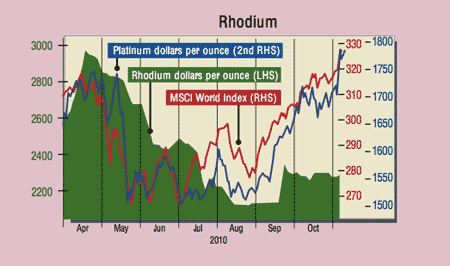
Platinum and its lesser-known cousin, palladium, have been on a roll lately (see chart below). Both metals are heavily used in catalytic converters for vehicles (auto catalysts account for 32% of platinum demand, and 52% of palladium). Their prices have kept pace with global stocks this year, moving higher roughly in sync with the MSCI World Index of global stocks. So not much evidence of a slowdown in industrial demand here, you might think.
But another platinum group metal, rhodium, which is also used in catalytic converters for vehicles, paints a different picture. Platinum and palladium are also used in jewellery and can be easily purchased by investors via exchange-traded funds (ETFs), so demand isn’t based purely on the car industry. But a full 86% of rhodium demand comes from catalysts. That makes it a much more useful guide to industrial activity.
The bad news is that the rhodium price is down by more than 20% since this year’s high in April, says analyst Park So Yeon on Bloomberg. Unlike copper, rhodium supplies aren’t under pressure, so any price drop can be explained largely by demand. As Park notes, this “weakness in the price suggests that economic fundamentals still lack momentum”. As a result, “the rally in global equities, largely driven by expectations for further quantitative easing measures, may take a pause”.